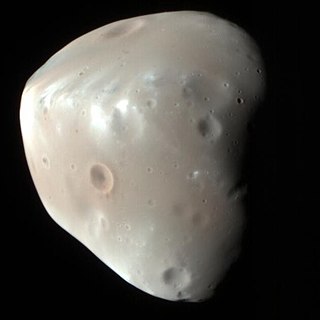
Phobos is the innermost and larger of the two natural satellites of Mars, the other being Deimos. The two moons were discovered in 1877 by American astronomer Asaph Hall. It is named after Phobos, the Greek god of fear and panic, who is the son of Ares (Mars) and twin brother of Deimos.

Deimos is the smaller and outer of the two natural satellites of Mars, the other being Phobos. Deimos has a mean radius of 6.2 km (3.9 mi) and takes 30.3 hours to orbit Mars. Deimos is 23,460 km (14,580 mi) from Mars, much farther than Mars's other moon, Phobos. It is named after Deimos, the Ancient Greek god and personification of dread and terror.
The Planetary Observer program is a cancelled space exploration program designed by NASA to provide cheaper planetary orbiters by using Earth-orbiting satellite components and technology, using solar panels for power, and a common spacecraft bus platform for all Planetary Observer-class probes. Only one spacecraft of this class was eventually constructed—the Mars Observer.
Wesley T. Huntress, Jr. is an American space scientist. An astrochemist and space scientist, Huntress worked for about twenty years at NASA's Jet Propulsion Laboratory. During the 1980s, he was also a video game designer, producing games for Apple computers. In 1988, Huntress moved to NASA headquarters, where he would serve in several positions, including Director of NASA's Solar System Exploration Division and Associate Administrator for Space Science.

Pascal Lee is co-founder and chairman of the Mars Institute, a planetary scientist at the SETI Institute, and the Principal Investigator of the Haughton–Mars Project (HMP) at NASA Ames Research Center in Mountain View, California. He holds an ME in geology and geophysics from the University of Paris, and a PhD in astronomy and space sciences from Cornell University.

Lucien Rudaux was a French artist and astronomer, who created famous paintings of space themes in the 1920s and 1930s.
David A. Hardy is a British space artist.
The International Association of Astronomical Artists (IAAA), is a non-profit organization whose members implement and participate in astronomical and space art projects, promote education about space art and foster international cooperation in artistic work inspired by the exploration of the Universe.

Ron Miller is an American illustrator and writer who lives and works in South Boston, Virginia. He now specializes in astronomical, astronautical and science fiction books for adults and young adults.

Rosaly M. C. Lopes is a planetary geologist, volcanologist, an author of numerous scientific papers and several books, as well as a proponent of education. Her major research interests are in planetary and terrestrial surface processes with an emphasis on volcanology.

Space art, also known as astronomical art, is a genre of art that visually represents the universe through various artistic styles. It may also refer to artworks sent into space.
Don Dixon is an American astronomical artist practicing space art in the tradition of Chesley Bonestell.
Jon Lomberg is an American space artist and science journalist. He was Carl Sagan's principal artistic collaborator for more than twenty years on many projects from 1972 through 1996. In 1998, the International Astronomical Union officially named an asteroid in recognition of his achievements in science communication. He was NASA's Design Director for the Golden Record on the Voyager spacecraft; the cover he designed is expected to last at least a billion years.
The Jonathan Eberhart Planetary Sciences Journalism Award was established by the Division for Planetary Sciences to recognize and stimulate distinguished popular writing on planetary sciences. The winning author receives a prize of $1,000, plus a citation. The award is named after science journalist Jonathan Eberhart.

Planetary science is the scientific study of planets, celestial bodies and planetary systems and the processes of their formation. It studies objects ranging in size from micrometeoroids to gas giants, with the aim of determining their composition, dynamics, formation, interrelations and history. It is a strongly interdisciplinary field, which originally grew from astronomy and Earth science, and now incorporates many disciplines, including planetary geology, cosmochemistry, atmospheric science, physics, oceanography, hydrology, theoretical planetary science, glaciology, and exoplanetology. Allied disciplines include space physics, when concerned with the effects of the Sun on the bodies of the Solar System, and astrobiology.

Luděk Pešek was a Czech artist and novelist. He was noted for his representations of astronomical subjects. The asteroid 6584 Ludekpesek is named after him. He was influenced by Lucien Rudaux.

Emily Stewart Lakdawalla is an American planetary geologist and former Senior Editor of The Planetary Society, contributing as both a science writer and a blogger. She has also worked as a teacher and as an environmental consultant. She has performed research work in geology, Mars topography, and science communication and education. Lakdawalla is a science advocate on various social media platforms, interacting with space professionals and enthusiasts on Facebook, Google+ and Twitter. She has appeared on such media outlets as NPR, BBC and BBC America.
The UK Centre for Astrobiology was set up at the University of Edinburgh in 2011 by Charles Cockell. It was set up as a UK node, formally affiliated as an international partner with the NASA Astrobiology Institute (NAI) alongside other national nodes until the NAI's dissolution in 2019. It was established as a virtual centre to sit at the interdisciplinary boundary of planetary sciences/astronomy and biological/earth sciences investigating numerous aspects of life in the universe, specifically 'how habitable worlds form in the Universe and how life emerges, proliferates and leaves traces on these worlds' as well as engaging in work on the robotic and human exploration of space and in space ethics, philosophy and governance.









